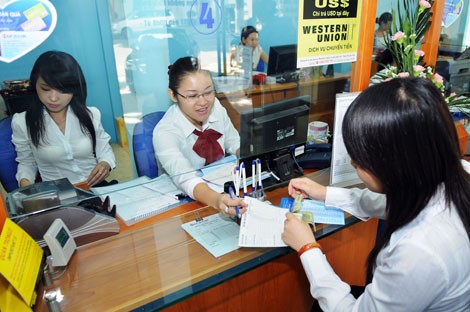(VOVworld) – In the master-plan on economic restructuring approved by the Prime Minister last year, bank restructuring and handling bad debts are considered key tasks. The settlement of bad debt has gained initial results after the program to restructure the banking system was launched 3 years ago.
 |
| Bad debts remain one of difficulties for the restructuring of Vietnam’s bank system. |
Over the past 3 years, the banking system cleared about 11.6 billion USD of bad debts. Credit institutions have set aside about 3.30 billion USD each year as a long-term capital reserve to deal with non-performing loans (NPLs). Since 2012, when the scheme to settle bad debts in the banking system was initiated, the ratio of bad debts has been lowered from 17% to 3.8% as of the end of September, 2014.
Nguyen Duc Vinh, General Director of the Vietnam Prosperity Bank (VPBank), said bad debt is not a desperate matter if it’s within control. He shared his bank’s experience:
‘The banking sector has created special task forces to keep a close eye on, assess, and analyze debts because it’s impossible for one bank to do the job. We have a 3-to-4-year plan to gradually retire bad debts. We should increase payable debts, the growth of demand instead of devoting too many resources to just settling bad debts.’
The State Bank of Vietnam’s Deputy Governor Nguyen Thi Hong says the central bank defines bad debt using international standards and based on a clients’ real ability to pay. It has asked credit institutions to curb the rise of bad debts, especially with new loans. Ms. Hong said:
“We need a strong financial resource to handle bad debt. The experience of other countries shows that it often costs a lot of money, even 30 or 40% of GDP to resolve the debts. Vietnam’s recent cleaning up of bad debts via the Vietnam Asset Management Company allowed credit institutions to sell bad debts for special bonds which can be used as collateral to secure loans from the central bank at 2% below the normal lending rate. In regards to operations by the State Bank of Vietnam, revolving bad debts is not the only target of the bank, but inflation control, macro-economic stabilization, and ensuring of the system’s safety are top priorities.”
At the 8th session of the ongoing National Assembly, many deputies agreed with the GDP growth target of 6.2% the government has set for next year. But to reach this target, the restructuring of the banking system and bad debt settlement should be combined with the overall restructuring of the economy with a focus on greater production and trading, fighting losses of tax collection, and smuggling, more cautious government spending.